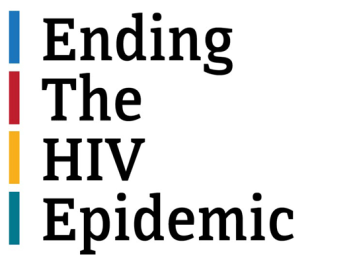

The Ending the HIV Epidemic (EHE) Initiative is a collaborative effort across U.S. federal agencies to reduce the number of new HIV infections in the United States by 75 percent by 2025, and then by at least 90 percent by 2030, for an estimated 250,000 total HIV infections averted. The Ryan White HIV/AIDS Program is a key player in this effort. Many recipients and TA providers have received funding for intensive local and regional program planning, coordination, and implementation activities. Access the latest RWHAP data reports and slide decks, including the EHE Data Report.
See AHEAD.HIV.gov to track the initiative's progress and access TAP-in TA/training for EHE jurisdictions.
Subtopics
Best Practices
- HRSA Bureau of Primary Health Care (BPHC), Centers for Disease Control and Prevention (CDC)Toolkit to help Health Centers expand the provision of HIV services.
Resources
- AETC National Coordinating Resource Center (NCRC)
HIV clinical training resources for HRSA's AIDS Education and Training Centers Program.
- Technical Assistance Provider Innovation Network (TAP-in)Guide for EHE jurisdictions on what they can do to enhance implementation of long-acting injectable antiretroviral therapy.
- National Clinician Consultation Center
Healthcare providers can receive no-cost expert clinical consultation in HIV prevention & care, HCV treatment, and substance use management.
- Data Integration, Systems and Quality (DISQ) Team, RWHAP Data SupportThis resource provides an overview of each TA provider resource
- Ryan White Data SupportInstructions on how all EHE recipients can access, complete, and submit the EHE Allocations Report.
- Ryan White Data SupportInstructions on how all EHE recipients can access, complete, and submit the EHE Expenditures Report.
- Technical Assistance Provider Innovation Network (TAP-in)
This toolkit provides guidance and best practices on the evaluation of social media/media (SMM) campaigns. The information is meant to serve as a starting point for EHE jurisdictions to help you decide how best to measure the success of your SMM campaigns.
- Technical Assistance Provider Innovation Network (TAP-in)
Surveys for clients can be administered in clinic/agency settings to determine if the campaign influenced clients to seek care at the agency/clinic. The sample survey can be adopted to evaluate the reach and response to social and traditional media campaigns.
- Technical Assistance Provider Innovation Network (TAP-in)Guidance and best practices on the evaluation of social media/media (SMM) campaigns.
- Technical Assistance Provider Innovation Network (TAP-in)
These campaign examples showcase different media campaigns.
- Technical Assistance Provider Innovation Network (TAP-in)
Through our work with EHE jurisdictions on monitoring and evaluation of social media/media (SMM) campaigns, TAP-in developed some initial guidance and tools that can serve as a starting point for EHE-funded jurisdictions in planning for and implementing how they are going to track and measure suc
- Technical Assistance Provider Innovation Network (TAP-in)
Below are useful links to help determine the metrics of various platforms. Some are direct from the platform companies (e.g., Facebook) while others are examples from firms or consultants that provide overviews on their webpages.
- Technical Assistance Provider Innovation Network (TAP-in)
The examples listed are from the Atlanta>AIDS Campaign, an EHE-funded, geographically targeted social media campaign to improve engagement in HIV care that used a variety of social media channels.
- TargetHIVFor inspiration, adaptation, or replication, explore some recent outreach efforts from government and community agencies.
- Data Integration, Systems and Quality (DISQ) TeamTools to provide reporting guidance for recipients and providers that receive Ending the HIV Epidemic (EHE) Initiative funding.
- Technical Assistance Provider Innovation Network (TAP-in)What HIV care providers can do to create a rapid ART program to get HIV clients on treatment the same day as a diagnosis.
- EHE Systems Coordination ProviderList of local and state EHE points of contact.
- HRSA HIV/AIDS Bureau (HAB)Compilation of resources available to assist jurisdictions with ending the HIV epidemic activities.
- Centers for Disease Control and Prevention (CDC)
Federal agency within HHS responsible for promotion of health and well-being of Americans.
- SAMHSA
U.S. federal agency that leads public health efforts to advance the behavioral health of the nation.
- U.S. Department of Health and Human Services
Portal for HIV/AIDS information from the U.S. federal government, including the Ending the HIV Epidemic initiative.
- U.S. Department of Housing and Urban Development
Information and training resources for various community development programs under the auspices of HUD, including HOPWA, Housing Opportunities for Persons with AIDS.
- Technical Assistance Provider Innovation Network (TAP-in)Imagine: Ending HIV. It’s Possible. is TAP-in's national campaign to inspire the HIV workforce to end the HIV epidemic by reducing the number of new HIV infections by 90% by 2030.
Webinars
- HRSA HIV/AIDS Bureau (HAB)
Webinars and other special events by HRSA's HIV/AIDS Bureau.
- Data Integration, Systems and Quality (DISQ) TeamReview of reporting requirements for EHE-funded recipients and providers.
- Technical Assistance Provider Innovation Network (TAP-in)Role of health centers in increasing PrEP access and use among women.
- Technical Assistance Provider Innovation Network (TAP-in)Learn how to improve messaging about HIV prevention and care to improve acceptance of services among all Black women.
- Technical Assistance Provider Innovation Network (TAP-in)In 2021, the U.S. public was introduced to a bi-monthly injectable form of PrEP, which stands for Pre-Exposure Prophylaxis.
- Technical Assistance Provider Innovation Network (TAP-in)Review of types of injectable long lasting HIV prevention and treatment medications and their similarities and differences.
- Technical Assistance Provider Innovation Network (TAP-in)Review of concept of status neutral (access to HIV services regardless of HIV status).
- Technical Assistance Provider Innovation Network (TAP-in)A status neutral approach can create a one door approach for HIV prevention and treatment, which can help normalize both.
- Technical Assistance Provider Innovation Network (TAP-in)Recordings of the TAP-in webinars on topics critical to the Ending the HIV Epidemic Initiative.
- IHAP TA Center
Discussion of how RWHAP recipients can leverage or align local Getting To Zero (GTZ) or Ending The Epidemic (ETE) initiatives to accomplish integrated planning objectives.